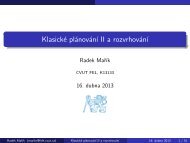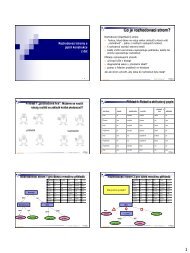AE4M33RZN, Fuzzy logic: Fuzzy relations
AE4M33RZN, Fuzzy logic: Fuzzy relations
AE4M33RZN, Fuzzy logic: Fuzzy relations
You also want an ePaper? Increase the reach of your titles
YUMPU automatically turns print PDFs into web optimized ePapers that Google loves.
<strong>AE4M33RZN</strong>, <strong>Fuzzy</strong> <strong>logic</strong>:<br />
<strong>Fuzzy</strong> <strong>relations</strong><br />
Radomír Černoch<br />
<br />
Faculty of Electrical Engineering, CTU in Prague<br />
26/11/2012
Organizational:<br />
• Next week, there will be a short test (max 5 points).<br />
• This week we are having the last theoretical lecture.
<strong>Fuzzy</strong> implication<br />
We already know fuzzy negation ¬ ∘ , fuzzy conjunction ∧ ∘ and fuzzy<br />
discjunction ∘ ∨. What about other operators?<br />
Definition<br />
<strong>Fuzzy</strong> implication is any function<br />
∘<br />
⇒ ∘ ∶ [0, 1] 2 → [0, 1] (1)<br />
which overlaps with the boolean implication on x, y ∈ {0, 1}:<br />
(x ∘ ⇒ ∘ y) = (x ⇒ y) . (2)
Generalized fuzzy inclusion<br />
Previously, we used the <strong>logic</strong>al negation ¬ ∘ to define the set<br />
complement, the conjunction ∧ ∘ to define the set intersection, etc.<br />
Can we use the implication ∘ ⇒ ∘ to define the the fuzzy inclusion?<br />
Definition<br />
The generalized fuzzy inclusion ∘ ⊆ ∘ is a function that assigns a degree to<br />
the the inclusion of set A ∈
Generalized fuzzy inclusion: Example
<strong>Fuzzy</strong> inclusion (non-generalized)<br />
Definition<br />
The fuzzy inclusion ⊆ is a predicate (assigns a true/false value) which<br />
hold for two fuzzy sets A, B ∈
Cutworhiness: Examples<br />
• The theorem 214 can be stated as: “Set inclusion is<br />
cut-consistent.”<br />
Brain teasers<br />
• Strong normality of A is defined as A(x) = 1 for some x ∈ Δ.<br />
iff every cut strongly normal. iff every its cut is non-empty<br />
A is strongly-normal Strong normality is cut-consistent:<br />
• Being crisp is<br />
cutworthy, but not cut-consistent:<br />
Every cut is crisp by definition, therefore cutworthiness.<br />
But even non-crisp sets have crisp cuts,<br />
therefore the property is not not cut-consistent.
Google: “fuzzy”<br />
Sources: M. Taylor's Weblog, M. Taylor's Weblog, Eddie's Trick Shop.
Google: “probability”<br />
Sources: Life123, WhatWeKnowSoFar, Probability Problems.
<strong>Fuzzy</strong> vs. probability<br />
• Vagueness vs. uncertainty.<br />
• <strong>Fuzzy</strong> <strong>logic</strong> is functional.
Crisp <strong>relations</strong><br />
Definition<br />
A binary crisp relation R from X onto Y is a subset of the cartesian<br />
product X × Y:<br />
R ∈ ℙ(X × Y) (12)<br />
Definition<br />
The inverse relation R -1 to R is a relation from Y to X s.t.<br />
R -1 = {(y, x) ∈ Y × X | (x, y) ∈ R} (13)
Crisp <strong>relations</strong>: Inverse<br />
Definition<br />
Let X, Y, Z be sets. Then the compound of <strong>relations</strong> R ⊆ X × Y, S ⊆ Y × Z<br />
is the relation<br />
R ○ S = {(x, z) ∈ X × Z | (x, y) ∈ R and (y, z) ∈ S for some y} (14)
Crisp <strong>relations</strong>: Properties<br />
The equality relation on Δ is E = {(x, x) | x ∈ Δ}.<br />
Then the relation R ⊆ Δ × Δ is called<br />
property using <strong>logic</strong>al connectives using set axioms<br />
reflexive ∀x. (x, x) ∈ R E ⊆ R<br />
symmetric (x, y) ∈ R ⇒(y, x) ∈ R R = R -1<br />
anti-symmetric (x, y) ∈ R ∧(y, z) ∈ R ⇒ y = z R ∩ R -1 ⊆ E<br />
transitive (x, y) ∈ R ∧(y, z) ∈ R ⇒(x, z) ∈ R R ○ R ⊆ R<br />
partial order reflexive, transitive and anti-symmetric<br />
equivalence reflexive, transitive and symmetric
<strong>Fuzzy</strong> <strong>relations</strong><br />
Definition<br />
A binary fuzzy relation R from X onto Y is a fuzzy subset on the<br />
universe X × Y.<br />
R ∈
Projection<br />
Defintion<br />
Let R ∈
Projection: Example<br />
R y 1 y 2 y 3 y 4 y 5 y 6 R (1) (x)<br />
x 1 0.1 0.2 0.4 0.8 1 0.81<br />
x 2 0.2 0.4 0.8 1 0.8 0.61<br />
x 3 0.4 0.8 1 0.8 0.4 0.21<br />
R (2) (y)0.4<br />
0.8<br />
1<br />
0.8<br />
0.4<br />
0.2<br />
Sometimes there is a total projection defined as<br />
R (T) = ⋁ x∈X ⋁ y∈Y R(x, y). But we already know this notion as<br />
Height(R).
Cylindrical extension<br />
Can we reconstruct a fuzzy relation from its projections? There is an<br />
unique largest relation with prescribed projections:<br />
Definition<br />
Let A ∈
Cylindrical extension: Drawing<br />
⎧<br />
⎪x<br />
− 1 x ∈ [1, 2]<br />
⎪<br />
A(x) = ⎨3<br />
− x x ∈ [2, 3]<br />
⎪<br />
⎪0<br />
otherwise<br />
⎩<br />
⎧<br />
⎪x<br />
− 3 x ∈ [3, 4]<br />
⎪<br />
B(x) = ⎨5<br />
− x x ∈ [4, 5]<br />
⎪<br />
⎪0<br />
otherwise<br />
⎩
Composition of fuzzy <strong>relations</strong><br />
Definition<br />
Let X, Y, Z be crisp sets. R ∈
Example of a fuzzy relation<br />
⎧<br />
⎪x<br />
+ y x, y ∈
Properties of fuzzy <strong>relations</strong><br />
Then the relation R ⊆ Δ × Δ is called<br />
property using set axioms<br />
reflexive E ⊆ R<br />
symmetric R = R -1<br />
∘-anti-symmetric R ∩ ∘ R -1 ⊆ E<br />
∘-transitive R ○ ∘ R ⊆ R<br />
∘-partial order reflexive, ∘-transitive and ∘-anti-symmetric<br />
∘-equivalence reflexive, ∘-transitive and ∘-symmetric
Properties in a finite domain<br />
If the universe Δ is finite, the relation can be written as a matrix. Their<br />
properties are reflected in the relation's matrix:<br />
• Reflexivity: Cells on the main diagonalare 1<br />
• Symmetricity: Cells symmetric over the main diagonalare equal<br />
• Anti-symmetricity: Cells symmetric over the main diagonal<br />
.<br />
have conjunction equal to zero<br />
• For S- and A-anti-symmetricity,one of the elements must be zero<br />
• For L-anti-symmetricity,their sum must be less or equal to 1<br />
• Transitivity: More difficult (see example on the next slide).<br />
.<br />
.<br />
.<br />
.
Example on fuzzy relation properties<br />
Let Δ = {A, B, C, D} and R ∈
Theorem 234.<br />
Let R, S and T be <strong>relations</strong> (defined over sets that “make sense”) The<br />
following equations hold:<br />
R ○ ∘ E = R, E ○ ∘ R = R (21)<br />
(R ○ ∘ S) -1 = S -1 ○ ∘ R -1 (22)<br />
R ○ ∘ (S ○ ∘ T) = (R ○ ∘ S) ○ ∘ T (23)
Proof of 234.<br />
Proving (21) and (22) is trivial.<br />
S<br />
"R ○(S ○ T)"(x, w) =
Proof of 234 (contd.).<br />
S<br />
=
Extensions: Sometimes it is useful to consider...<br />
• ...a
Bibliography<br />
Navara, M. and Olšák, P. (2001).<br />
Základy fuzzy množin.<br />
Nakladatelství ČVUT.



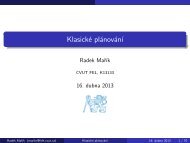
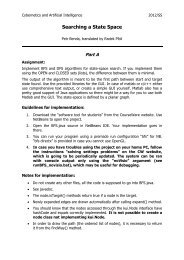

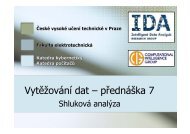
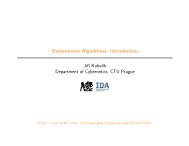
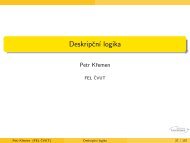


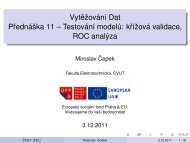
![RANSAC [Fischler, Bolles '81]](https://img.yumpu.com/17549294/1/190x143/ransac-fischler-bolles-81.jpg?quality=85)

